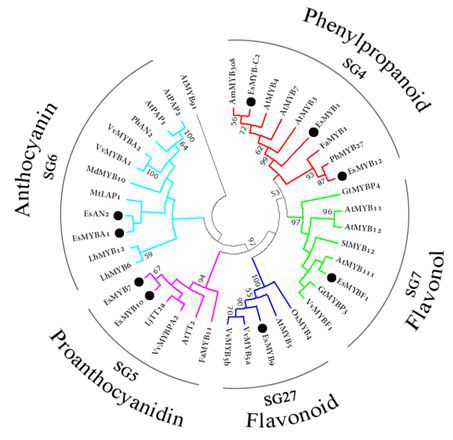EsAN2 and EsMYBF1 Enlighten the Biosynthesis and Regulation of the Flavonoid Pathway in Epimedium
2016-09-20
Herba epimedii, an important traditional Chinese medicine, is prepared from the dried leaves of Epimedium species. Epimedium has been used as a kidney tonic and antirheumatic medicinal herb for more than 2000 years. It had been well demonstrated that the main bioactive components in Epimedium plants are flavonoid compounds, especially C8-prenylated flavonol glycosides (e.g. icariin). As we know, the flavonoid pathway is one of the most studied pathways of plant secondary metabolites, but the related studies in Epimedium plants have been lagged behind.
WANG Ying’s group from Wuhan Botanical Garden researched the flavonoid biosynthesis and regulation in Epimedium plants. Two MYB transcription factors which were involved in regulating the flavonoid pathway were identified from E. sagittatum, including EsAN2 and EsMYBF1 .
EsAN2 gene can interact with basichelix–loop–helix (bHLH) regulators of the flavonoid pathway, and regulate the structural genes of the anthocyanin biosynthetic pathway. EsAN2 is mainly expressed in flowers, while EsMYBF1 is predominantly expressed in leaves which contain a large amount of the flavonol-derived bioactive components.
EsMYBF1 is independent of bHLH cofactors, and regulates the flavonol biosynthetic pathway genes (CHS, F3H and FLS), and thus participates in the regulation of the synthesis and accumulation of the flavonol-derived bioactive components in Epimedium. Both anthocyanin and flavonol belong to the flavonoid pathway, but locate at the different branches of this pathway.
Identification of these two MYB regulators will facilitatethe understanding of the molecular mechanisms of the biosynthesis and regulation of flavonoids-derived bioactive components, and also provides an effective gene tool for the metabolic engineering in future.
These results were published in Plant Cell Reports and Frontiers in Plant Science, respectively. The study were supported by the grants from National Natural Science Foundation of China.

MYB transcription factors involved in regulating the flavonoid biosynthetic pathway in Epimedium plant (Image by HUANG Wenjun)